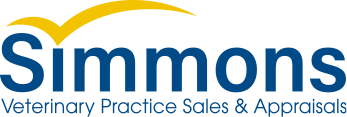By Joe Stephenson, MA – Simmons Northeast
As a veterinary business appraiser and broker, I see young veterinarians reared on cutting edge technology, hungry for practices thoroughly equipped with blinking lights and high-resolution screens.
I also see practice owners sink their earnings into new gadgets just before retiring. These seasoned owners hope their new cutting-edge practices will bring in the tech-hungry millennial buyers. Unfortunately, stuffing their practice full of new equipment often strips their practice value. Read on to learn why.
Medical Technology Is an Investment
The demand for more cutting-edge medical technology is a veterinary business reality. With the technology comes increased average expenses, but the cost of falling too far behind might be greater than the cost of updating equipment. The key is to think about buying equipment as an investment. You need to have the capital to invest, have a concrete plan, and need enough time to see a return on that investment.
Timing Is Everything
Let’s start with the capital and time to return. This means that you shouldn’t invest in pricey equipment right after you buy a practice, and you shouldn’t invest in pricey equipment just before you retire. Early on, after buying a practice, your debt payments will take up a large part of your earnings.
You shouldn’t invest in equipment just before retirement for many reasons.
• When selling your practice, your equipment only has value in as much as it’s producing earnings.
• A practice sells free and clear of debt. That means the buyer doesn’t take on your loans; you pay them out of the closing proceeds.
• Every dollar you add to your earnings is worth up to $6 in practice value.
If you just sunk a major share of your earnings into equipment and you haven’t had enough time to see a return on your investment, that equipment might drag your practice down into No-Lo depths. The ideal time to invest in equipment is after you’ve had time to understand your business flow and at least 5 years before you want to retire.
Know What You Need
Even if you’re in the right career position to invest in equipment, you still need to step back and make sure it improves your medicine quality and is a sound business decision. To gain perspective and slightly reduce the risk of making a bad decision, I suggest owners perform a full feasibility analysis to see if the equipment is really worth it.
A feasibility analysis is a tool to gain perspective on a potential investment or business decision. Here I just want to give you some information on roughing out a potential return on investment (ROI), a major part of your feasibility analysis.
Assess Your Veterinary Practice’s Health
Before rushing into investing in new equipment, you should at least know about your practice’s health and whether or not you are even in a position to invest. When was the last time you had a management-based appraisal (MBA) done? A skilled valuator can point out profit centers and weaknesses in your practice. If you’ve kept up with the suggested MBA every 3-5 years, you can refer back to it to help you understand your practice’s current health. If not, it’s time to get one done to see if you’re even in a position to invest — lagging technology could be the least of your problems.
Once you fully understand your practice’s health, you’ll be in a great position to make a plan to ensure that you actually see a return on that equipment investment and be incur the cost of veterinary technology.
Estimate Equipment Cost
If you are in a position to invest, start by estimating the equipment’s actual cost. For example, take a $50,000 piece of equipment bought with a loan. These low-interest rates won’t last, so to be conservative, consider a 5-year loan with an 8.5% interest rate, which results in $11,550 in interest through the life of the loan.
In this example, I’m assuming the equipment will depreciate over 5 years. The equipment may retain some residual value and continued use, but the rapid rate of technology growth is rendering a shorter useful life. You can depreciate the equipment either in the first year or through its estimated useful life. The tax savings from depreciation will be about 35%, bringing the cost down to $32,500. Adding the interest from the $50,000 loan brings your actual cost to $44,050.
Also, consider additional costs you might incur. Do you need renovations or to pay installation fees? You may need to hire new staff, and you will need to train your existing staff and possibly yourself.
After researching, assume you have to invest an estimated $1,000 in installation and training. You might also consider the offered service plan for some equipment. Some practice owners never need to use their plans, but we’ve also seen brand-new digital x-rays fall apart in the first year. A $2,000 annual service plan isn’t bad compared to a new $50,000 piece of equipment.
Including the installation costs, the training, the service plan, and the interest, less the tax savings, your initial investment is $47,050. With an estimate of the actual cost, you can build an ROI calculation.
Build an ROI Estimate
To get to your ROI, start with your annual cost. The annual cost is the actual cost divided by the useful life of the equipment. Over 5 years, that’s $9,410 (see Table 1).
Usage Goal
Once you have the annual cost, you need to set a usage goal. If it’s a brand new piece of equipment, estimate how much you think you will need to use it to see a return. If it’s just an upgrade of existing equipment, such as going to your first digital x-ray, don’t expect to achieve a huge initial usage jump. Set a reasonable goal over several years, e.g., 200.
Fixed Cost Per Use
Fixed cost per use is just your annual cost divided by your number of uses: 9,410/200=47.05 (see Table 1). In addition to the fixed cost, the equipment will have some variable costs. These are personnel costs and materials costs. Table 1 assumed some minor materials costs of $2 and $20 personnel costs. This puts the total cost per use at $69.05.
Set Potential Price Per Use
Using the cost estimate per use, apply a markup to set a potential price per use. You should start with a 50-100% markup. Remember, this equipment has to pay for itself, pay you a return, account for variables you didn’t consider, and pay for the utilities and amount of space it takes up in your building.
In Table 2, we started with a 50% markup, which puts the price at $104 (69.05*1.5). In year zero, you put your total costs as an expense. Each subsequent year includes the service plan as an expense. Next, consider your number of uses. Don’t assume you’ll hit your goal right away. You can see in Table 2 that we started with 75 uses and worked up to 200 in year 4.
Calculate Yearly Revenue
To get your revenue for each year, multiply your price minus your variable costs by your estimated usage for that year, e.g., in year 1: (104-22)*25=6,118 (see Table 2). For calculating your gain in each year, start with your total initial cost as a negative in year 0. For each year, add the revenue minus the expense for that year to the previous year’s gain, e.g., in year 1: -47,050+(6,118-2,000)= -42,932 (see Table 2).
Arrive at Your ROI
With an estimated gain and cost, you can estimate your ROI (gain-cost/cost). Take your average annual revenue from Table 2 and subtract it from your average annual expense. This gives you your average annual gain (12,644 – 11,410 = 1,234) (see Table 3). Divide that number by the average annual cost for your ROI estimate (1,234/11,410 = 10.82%).
10.8 % is a great ROI. Before moving forward, though, you should perform a sensitivity analysis. Change one calculation variable and see how that changes the ROI. Changing the number of uses or the percentage markup could drastically change the outcome. For reference, I included Table 4.
As you can see, only changing the markup to 25% results in a considerable loss.
Don’t Let Your Technological Growth Impede Your Financial Growth
Demand for high-tech equipment will continue to grow in veterinary medicine. You just have to think of equipment as an investment. Don’t invest before you’re ready if your practice isn’t healthy or if you don’t have enough time to see a return. If you’re in the right position, you just have to step back, think it through, and you should see continued financial growth along with your technological growth.
For more information on this or any other veterinary practice topic, reach out to the expert team at Simmons Veterinary Practice Sales and Appraisals. We’re here to guide you through buying, selling, or appraising your practice and enjoying success whatever you decide.



